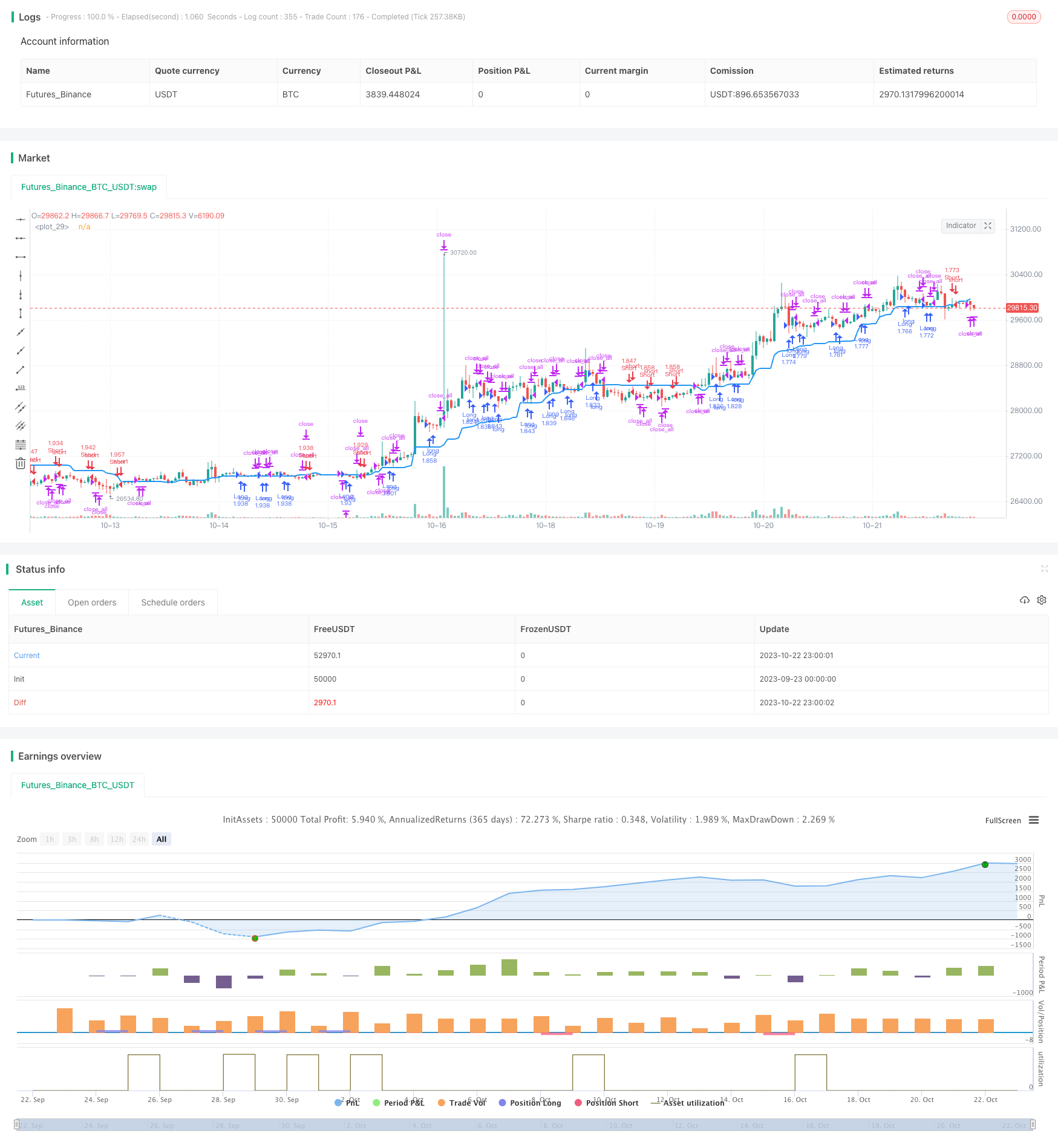
概述
Noro’s 值道策略v1.1是一个基于价值通道和价格变化方向的趋势交易策略。该策略结合价值通道指标和快速RSI指标,识别出突破价值通道的K线形态信号,并结合连续红绿K线的颜色反转信号来建立多空仓位。该策略旨在捕捉中长线趋势的方向,而避免被市场的短期波动所迷惑。
策略原理
该策略首先计算过去一定周期内的最高价和最低价的均值,构建出中间价值通道。当价格从通道下方向上突破该通道时,视为多头信号;当价格从通道上方向下跌破该通道时,视为空头信号。
与此同时,该策略结合两个辅助判断规则:快速RSI指标和K线颜色。当快速RSI低于25%时,认为处于超买状态,价格可能反弹;此时若价格突破通道上轨,产生较强的多头信号。相反,当快速RSI高于75%时,认为处于超卖区,价格可能下跌;此时若价格突破通道下轨,产生较强的空头信号。此外,策略还会统计最近两个K线的颜色变化。连续两个红色K线会增强空头信号,连续两个绿色K线会增强多头信号。
综合这三个信号指标,该策略可以有效识别中长线趋势,并及时建立仓位。当仓位方向与最新K线颜色相反时,认为趋势发生转变,此时平掉当前仓位。
策略优势
该策略最大的优势是结合多种指标判断趋势方向,避免被短期市场Noise所迷惑。具体来看,主要有以下几个方面的优势:
价值通道指标能清晰识别中长线趋势的方向和力度。价格突破通道上下轨时,代表趋势进入新的阶段,产生较强信号。
快速RSI指标能判断超买超卖现象,避免在转折点追逐趋势。例如超卖时买入,超买时卖出。
K线颜色判定能进一步验证趋势的持续性,如果颜色发生变化,则关闭当前仓位。
该策略只在连续两个同色K线突破通道时才开仓,避免被短期震荡误导。
平均止损方式简单有效,只要K线颜色发生变化就平仓,最大程度避免亏损扩大。
策略风险
该策略也存在一些风险需要注意,主要有:
价值通道参数设置不当,通道过于宽泛或者过于狭窄,会错过趋势转换点或者产生过多错误信号。
快速RSI参数设置不当,无法准确判断超买超卖现象,从而錯过反转机会。
平均止损方式可能在震荡趋势中过于敏感,造成仓位频繁开平。
无法判断突破价值通道后的具体运行走势,可能导致亏损放大。
无法应对黑天鹅事件的突发性冲击,会遭受巨大亏损。
优化方向
该策略还有以下几个主要优化方向:
动态调整价值通道参数,让通道能更好地适应不同周期和不同市场的波动。
结合波动率指标修正RSI参数,在大幅波动时降低敏感度,在低波动时提高敏感度。
加入移动止损机制,根据趋势波动幅度来设定止损位置,避免过于敏感地止损。
增加对突破力度和背驰现象的判断,避免出现虚假突破。
结合历史数据训练判断模型,辅助判断趋势转折高度可能的时段,提高开仓成功率。
优化仓位管理策略,根据风险状况动态调整仓位比例。
总结
Noro’s 值道策略v1.1整体来说是一个简单实用的趋势跟踪策略。它结合多种指标来识别中长线趋势方向,并设定较为谨慎的开仓规则。在优化止损机制、动态调整参数等方面还有进一步改进的空间。但该策略整体思路简单清晰,易于实际应用,非常适合作为量化交易的入门策略之一。随着参数调整和机制优化,该策略可以成为稳定可靠的量化系统。
/*backtest
start: 2023-09-23 00:00:00
end: 2023-10-23 00:00:00
period: 1h
basePeriod: 15m
exchanges: [{"eid":"Futures_Binance","currency":"BTC_USDT"}]
*/
//Noro
//2018
//@version=2
strategy(title = "Noro's Price Channel Strategy v1.1", shorttitle = "Price Channel str 1.1", overlay=true, default_qty_type = strategy.percent_of_equity, default_qty_value = 100, pyramiding = 0)
//Settings
needlong = input(true, defval = true, title = "Long")
needshort = input(true, defval = true, title = "Short")
usecol = input(true, defval = true, title = "Use color strategy")
usersi = input(true, defval = true, title = "Use RSI strategy")
lev = input(1, defval = 1, minval = 1, maxval = 100, title = "leverage")
pch = input(30, defval = 30, minval = 2, maxval = 200, title = "Price Channel")
showcl = input(true, defval = true, title = "Show center-line")
fromyear = input(1900, defval = 1900, minval = 1900, maxval = 2100, title = "From Year")
toyear = input(2100, defval = 2100, minval = 1900, maxval = 2100, title = "To Year")
frommonth = input(01, defval = 01, minval = 01, maxval = 12, title = "From Month")
tomonth = input(12, defval = 12, minval = 01, maxval = 12, title = "To Month")
fromday = input(01, defval = 01, minval = 01, maxval = 31, title = "From day")
today = input(31, defval = 31, minval = 01, maxval = 31, title = "To day")
src = close
//Price channel
lasthigh = highest(src, pch)
lastlow = lowest(src, pch)
center = (lasthigh + lastlow) / 2
trend = low > center ? 1 : high < center ? -1 : trend[1]
col = showcl ? blue : na
plot(center, color = col, linewidth = 2)
//Bars
bar = close > open ? 1 : close < open ? -1 : 0
rbars = sma(bar, 2) == -1
gbars = sma(bar, 2) == 1
//Fast RSI
fastup = rma(max(change(src), 0), 2)
fastdown = rma(-min(change(src), 0), 2)
fastrsi = fastdown == 0 ? 100 : fastup == 0 ? 0 : 100 - (100 / (1 + fastup / fastdown))
//Signals
body = abs(close - open)
abody = sma(body, 10)
up1 = rbars and close > center and usecol
dn1 = gbars and close < center and usecol
up2 = fastrsi < 25 and close > center and usersi
dn2 = fastrsi > 75 and close < center and usersi
exit = (((strategy.position_size > 0 and close > open) or (strategy.position_size < 0 and close < open)) and body > abody / 2)
lot = strategy.equity / close * lev
//Trading
if up1 or up2
if strategy.position_size < 0
strategy.close_all()
strategy.entry("Long", strategy.long, needlong == false ? 0 : lot, when=(time > timestamp(fromyear, frommonth, fromday, 00, 00) and time < timestamp(toyear, tomonth, today, 23, 59)))
if dn1 or dn2
if strategy.position_size > 0
strategy.close_all()
strategy.entry("Short", strategy.short, needshort == false ? 0 : lot, when=(time > timestamp(fromyear, frommonth, fromday, 00, 00) and time < timestamp(toyear, tomonth, today, 23, 59)))
if time > timestamp(toyear, tomonth, today, 23, 59) or exit
strategy.close_all()